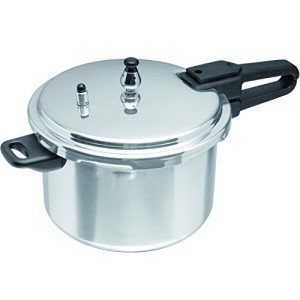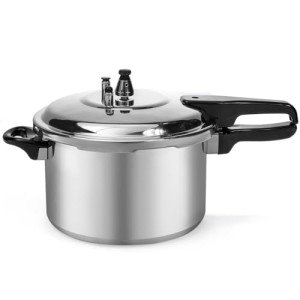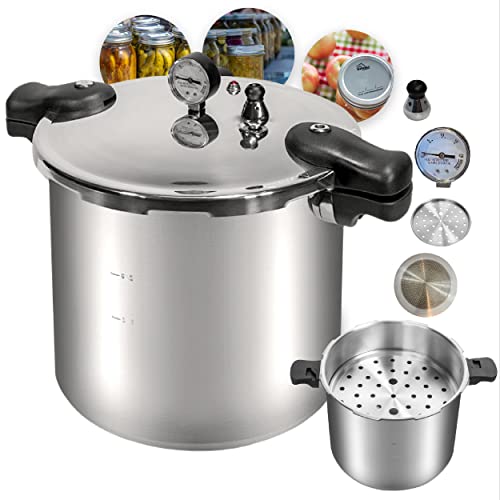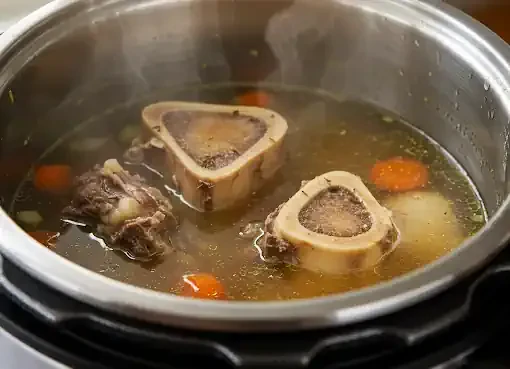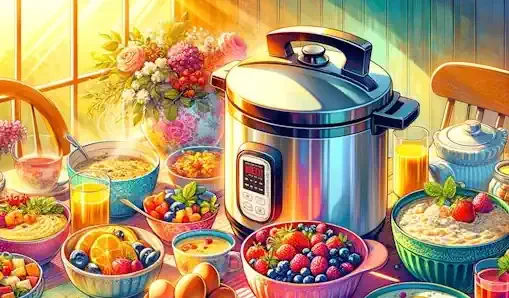Introduction
Setting the Stage: The Culinary Marvel
In the bustling kitchens of today's homes, there exists a silent hero, often overlooked yet profoundly influential—the pressure cooker. This unassuming kitchen appliance has revolutionized the way we cook, offering efficiency, versatility, and unparalleled results. But behind its humble exterior lies a rich tapestry of history, innovation, and culinary prowess.
Historical Evolution: From Humble Beginnings to Modern Marvel
The journey of the pressure cooker traces back to the early 17th century when French physicist Denis Papin conceptualized the idea of a vessel that could harness steam pressure to cook food rapidly. However, it wasn't until the 20th century that pressure cookers gained widespread popularity, thanks to advancements in manufacturing and safety features.
Initially utilized for industrial purposes, pressure cookers soon found their place in domestic kitchens, offering a solution to the time-consuming nature of traditional cooking methods. Over the decades, they evolved from rudimentary designs to sleek, efficient appliances, becoming an indispensable tool for home cooks and professional chefs alike.
Purpose of the Article: Unveiling the Multifaceted Pressure Cooker
In this comprehensive guide, we embark on a journey to uncover everything about the pressure cooker. Beyond its utilitarian function, we delve into the mechanics behind its operation, explore its myriad benefits, and celebrate its cultural significance. Whether you're a seasoned chef or a novice cook, this article aims to equip you with the knowledge and inspiration to harness the full potential of this culinary marvel.
Join us as we unravel the mysteries of the pressure cooker, from its humble origins to its enduring legacy in kitchens around the world. Brace yourself for a tantalizing exploration of one of the most transformative inventions in culinary history—the pressure cooker.
Understanding the Mechanics
How Pressure Cookers Work: Unlocking the Science of Steam
At the heart of every pressure cooker lies a simple yet ingenious principle: the power of steam. Unlike conventional cooking methods that rely on boiling water at 100°C (212°F), pressure cookers operate under higher pressure, allowing water to reach temperatures well above its boiling point. This elevated pressure increases the kinetic energy of water molecules, facilitating faster cooking times and more efficient heat transfer.
When heat is applied to the pressure cooker, water inside the sealed vessel begins to boil, producing steam. As steam accumulates, pressure builds, exerting force on both the liquid and solid components of the food being cooked. This pressure not only accelerates the cooking process but also helps break down tough fibers in meats and legumes, resulting in tender, flavorful dishes in a fraction of the time.
Components Breakdown: Deciphering the Anatomy of a Pressure Cooker
To understand the inner workings of a pressure cooker, let's dissect its key components
Lid: The lid of a pressure cooker plays a crucial role in creating a tight seal, trapping steam and pressure inside the vessel. Most modern pressure cookers feature locking mechanisms and rubber gaskets to ensure a secure closure.
Pressure Regulator: Responsible for maintaining the desired pressure level inside the cooker, the pressure regulator typically consists of a weighted valve or spring-loaded mechanism. It releases excess steam to prevent pressure from exceeding safe limits.
Safety Valve: As an additional safety measure, pressure cookers are equipped with safety valves that automatically release pressure if the primary regulator fails or becomes blocked. This prevents the buildup of dangerously high pressure levels.
Base: The base of the pressure cooker contains the heating element (for electric models) or serves as the contact point with the stove burner (for stovetop models). It conducts heat to the cooking vessel, initiating the boiling process.
Safety Measures: Ensuring Peace of Mind in the Kitchen
While pressure cookers offer unparalleled speed and efficiency, they also demand respect and caution due to the high pressures involved. To ensure safe operation, it's essential to adhere to the following safety measures
Always read and follow the manufacturer's instructions carefully before using a pressure cooker.
Never overfill the cooker beyond its recommended capacity, as this can lead to dangerous pressure buildup.
Use caution when releasing pressure from the cooker, either through natural release or quick release methods, to prevent scalding from escaping steam.
Regularly inspect the pressure cooker for signs of wear or damage, such as worn gaskets or malfunctioning valves, and replace any faulty components promptly.
By understanding the mechanics of pressure cookers and implementing proper safety protocols, you can harness the full potential of this culinary powerhouse while ensuring a safe and enjoyable cooking experience. In the next section, we'll explore the myriad benefits that pressure cooking has to offer, from time-saving convenience to nutritional excellence.
Benefits Beyond Efficiency
Time-Saving Wonder: Redefining Efficiency in the Kitchen
One of the most compelling advantages of the pressure cooker is its ability to drastically reduce cooking times without compromising on flavor or nutritional value. Traditional cooking methods often require prolonged simmering or braising to achieve tender results, but pressure cookers expedite this process by harnessing the power of steam and pressure.
For example, a tough cut of meat that might take hours to tenderize through conventional methods can be transformed into succulent perfection in a fraction of the time with a pressure cooker. Similarly, dried beans and legumes, which typically require soaking and lengthy cooking times, can be cooked to creamy perfection in a matter of minutes under pressure.
By streamlining the cooking process, pressure cookers empower busy home cooks to prepare wholesome, homemade meals on even the busiest of weeknights. Whether it's a hearty stew, a batch of risotto, or a comforting bowl of chili, the pressure cooker excels at delivering satisfying results in record time.
Energy Efficiency: A Greener Approach to Cooking
In addition to saving time, pressure cookers are also eco-friendly alternatives to conventional cooking methods. By significantly reducing cooking times, they consume less energy and produce fewer greenhouse gas emissions, making them a sustainable choice for environmentally conscious consumers.
Consider this: while simmering a pot of soup on the stove may require continuous energy consumption for hours on end, a pressure cooker can achieve the same results in a fraction of the time, using significantly less electricity or gas. Over time, these energy savings can add up, resulting in reduced utility bills and a smaller carbon footprint.
Furthermore, the sealed nature of pressure cooking helps retain moisture and heat within the vessel, minimizing heat loss and further improving energy efficiency. This means less energy wasted on maintaining cooking temperatures and more efficient utilization of resources—a win-win for both the planet and your wallet.
Health Benefits: Nutritious and Delicious
Beyond time and energy savings, pressure cooking offers distinct health benefits that set it apart from other cooking methods. Unlike boiling or steaming, which can leach vitamins and minerals from foods into the cooking liquid, pressure cooking preserves the nutritional integrity of ingredients by minimizing nutrient loss.
The rapid cooking process and sealed environment of the pressure cooker help retain water-soluble vitamins like vitamin C and B vitamins, which are susceptible to degradation at high temperatures. Additionally, pressure cooking can break down tough fibers and cell walls in fruits, vegetables, and grains, enhancing their digestibility and bioavailability.
Furthermore, pressure cooking requires little to no added fats or oils, making it a heart-healthy cooking option for those looking to reduce their intake of saturated fats and cholesterol. With pressure cooking, you can enjoy delicious, nutrient-rich meals with minimal effort and maximal health benefits.
In the next section, we'll explore the versatility of pressure cookers in the kitchen, showcasing the wide range of dishes that can be prepared with ease using this innovative cooking method. Whether you're craving soups, stews, grains, or desserts, the pressure cooker has you covered.
Versatility in the Kitchen
Culinary Applications: Unleashing the Creative Potential
One of the most captivating aspects of the pressure cooker is its remarkable versatility in the kitchen. From hearty soups to delicate desserts, the pressure cooker can handle a wide array of dishes with ease, making it a must-have tool for culinary enthusiasts of all skill levels.
Imagine coming home after a long day to the comforting aroma of a simmering stew, or waking up to the enticing scent of freshly cooked oatmeal—all made possible with the magic of the pressure cooker. With its ability to tenderize tough cuts of meat, accelerate cooking times, and infuse flavors deeply into ingredients, the pressure cooker opens up a world of culinary possibilities.
Ingredient Adaptability: From Meats to Grains and Beyond
Whether you're cooking meat, poultry, seafood, grains, legumes, or vegetables, the pressure cooker proves itself to be a versatile ally in the kitchen. Tough cuts of meat that would traditionally require hours of braising or stewing can be transformed into fork-tender delicacies in a fraction of the time.
Similarly, dried beans and legumes, which typically necessitate soaking and extended cooking times, can be cooked to perfection in a matter of minutes under pressure. Grains like rice, quinoa, and farro cook quickly and evenly, resulting in fluffy, perfectly cooked grains every time.
The pressure cooker also excels at infusing flavors into ingredients, making it ideal for preparing stocks, broths, and sauces. By trapping steam and pressure inside the vessel, the pressure cooker helps ingredients meld together, creating depth of flavor that would otherwise require hours of simmering.
Ethnic Influence: Exploring Global Cuisine
From Indian dal to Latin American beans, pressure cooking plays a prominent role in cuisines around the world. In Indian cooking, the pressure cooker is indispensable for preparing dals, curries, and rice dishes with speed and efficiency. Similarly, in Latin American cuisine, pressure cookers are used to cook beans, stews, and meats, infusing dishes with rich, robust flavors.
In countries like Italy and Spain, pressure cookers are prized for their ability to tenderize tough cuts of meat and create deeply flavored sauces and stews. In China, pressure cookers are used to prepare a wide array of dishes, from braised meats to steamed buns.
Across continents and cultures, the pressure cooker serves as a unifying force in the kitchen, bridging culinary traditions and enabling home cooks to recreate beloved dishes with ease. In the next section, we'll delve deeper into the nuances of pressure cooker cooking, offering tips and techniques for achieving optimal results with this versatile appliance. Whether you're a seasoned chef or a novice cook, mastering the art of pressure cooking is sure to elevate your culinary repertoire.
Mastering the Art
Operating Instructions: Navigating the Pressure Cooking Experience
While pressure cookers offer unparalleled convenience and versatility, mastering the art of pressure cooking requires a solid understanding of its operation. Here's a step-by-step guide to using a pressure cooker safely and effectively
Preparation: Begin by assembling your ingredients and ensuring that the pressure cooker is clean and in good working condition. Check that the sealing ring is properly fitted and that the pressure release valve is unobstructed.
Adding Ingredients: Place the ingredients into the pressure cooker pot, taking care not to overfill beyond the maximum fill line indicated in the manufacturer's instructions. Adding too much liquid or ingredients can lead to excessive pressure buildup and may cause the cooker to malfunction.
Sealing the Lid: Once the ingredients are added, securely fasten the lid onto the pressure cooker, ensuring that it is properly aligned and locked into place. Some pressure cookers feature visual indicators or audible signals to indicate when the lid is properly sealed.
Selecting Pressure Settings: Depending on the recipe and the type of pressure cooker you're using, you may need to select a specific pressure setting. Most pressure cookers offer high and low-pressure settings, with high pressure being suitable for most recipes.
Starting the Cooking Process: Set the pressure cooker to the desired cooking time and pressure setting, then turn on the heat source (for stovetop models) or select the appropriate cooking program (for electric models). The pressure cooker will begin building pressure, indicated by the hissing sound of steam escaping from the pressure release valve.
Cooking Under Pressure: Once the pressure cooker reaches the desired pressure level, the cooking process begins. The pressure indicator may rise, indicating that pressure has been reached. From this point, the cooking time will commence, and the ingredients will cook under pressure.
Releasing Pressure: After the cooking time has elapsed, it's time to release the pressure from the cooker. There are two primary methods for releasing pressure: natural release and quick release. Natural release involves allowing the pressure to dissipate gradually on its own, while quick release involves manually venting the steam using the pressure release valve.
Safety Precautions: Exercise caution when releasing pressure from the cooker, as escaping steam can cause burns. Always use oven mitts or a kitchen towel to protect your hands, and never place your face or hands directly above the pressure release valve.
By following these operating instructions and safety precautions, you can confidently navigate the pressure cooking experience and unlock the full potential of your pressure cooker. In the next section, we'll delve into tips and tricks for achieving optimal results with this versatile kitchen appliance, from flavor enhancements to time-saving techniques. Whether you're a novice cook or a seasoned chef, mastering the art of pressure cooking is sure to elevate your culinary repertoire.
Tips and Tricks
Enhancing Your Pressure Cooking Experience
Pressure cooking is not just about following recipes—it's about understanding the nuances of this cooking method and leveraging its unique capabilities to create exceptional dishes. Here are some insider tips and tricks to help you achieve optimal results with your pressure cooker
Layer Flavors: Take advantage of the sealed environment of the pressure cooker to intensify flavors. Sauté aromatics like onions, garlic, and spices before adding other ingredients to build complexity and depth of flavor.
Deglaze the Pot: After sautéing ingredients, deglaze the pot with liquid (such as broth, wine, or water) to loosen any flavorful bits stuck to the bottom. This process not only adds flavor but also helps prevent the "burn" error on electric pressure cookers.
Adjust Cooking Times: While pressure cooking significantly reduces cooking times compared to traditional methods, it's essential to adjust recipes accordingly. As a general rule of thumb, cooking times for most dishes are approximately one-third to one-half of the time required for conventional cooking methods.
Use Natural Release for Tender Results: For dishes containing meats or delicate ingredients, opt for natural release to allow the pressure to dissipate gradually. This gentle release method helps prevent overcooking and ensures tender, succulent results.
Quick Release for Quick Results: When cooking vegetables or grains that benefit from precise timing, quick release is the preferred method. Simply turn the pressure release valve to vent steam rapidly, stopping the cooking process and preserving the texture and color of the ingredients.
Monitor Liquid Levels: Ensure that your pressure cooker contains enough liquid to generate steam and maintain pressure throughout the cooking process. Insufficient liquid can lead to scorching or burning, while excess liquid can dilute flavors and result in soupy dishes.
Experiment with Recipes: Don't be afraid to get creative and experiment with different recipes and ingredients in your pressure cooker. From soups and stews to risottos and desserts, the possibilities are endless. Start with familiar dishes and gradually expand your culinary repertoire as you gain confidence.
Practice Patience: While pressure cooking offers speed and efficiency, it's essential to allow time for the cooker to come to pressure and release pressure safely. Rushing these steps can compromise the quality of your dishes and pose safety risks.
By incorporating these tips and tricks into your pressure cooking routine, you'll unlock the full potential of your pressure cooker and elevate your culinary creations to new heights. In the next section, we'll address common pitfalls and how to troubleshoot them, ensuring a seamless pressure cooking experience every time. Whether you're a novice cook or a seasoned pro, mastering the art of pressure cooking is within reach with the right guidance and practice.
Troubleshooting
Navigating Common Pitfalls and Finding Solutions
While pressure cooking offers a convenient and efficient way to prepare meals, occasional challenges may arise along the way. Understanding how to troubleshoot common issues will help you overcome obstacles and ensure a smooth pressure cooking experience. Here's how to navigate some of the most common pitfalls
Food Burn: If your pressure cooker displays a "burn" error or you notice burnt residue on the bottom of the pot, it's likely due to insufficient liquid or ingredients sticking to the bottom. To remedy this, carefully release pressure, open the lid, and stir the contents to loosen any stuck-on bits. Add additional liquid if necessary and resume cooking, taking care to scrape the bottom of the pot to prevent further burning.
Overcooking: Overcooked vegetables or meats can result from excessive cooking times or using the wrong pressure setting. To salvage overcooked ingredients, remove them from the pressure cooker immediately and immerse them in ice water to halt the cooking process. Adjust cooking times or pressure settings for future recipes to achieve the desired level of doneness.
Undercooked Food: If your dish is undercooked after the recommended cooking time, it may be due to insufficient pressure buildup or incorrect temperature settings. Check that the pressure release valve is properly sealed and that the pressure cooker has reached the desired pressure level before starting the cooking timer. If necessary, extend the cooking time or increase the pressure setting and continue cooking until the food reaches the desired consistency.
Leaking Seal: A leaking seal or improperly sealed lid can result in loss of pressure and compromised cooking performance. Check the sealing ring for signs of wear or damage and ensure that it is properly seated in the lid groove. Clean and lubricate the sealing ring regularly to maintain its integrity and replace it if necessary. Additionally, ensure that the pressure release valve is securely closed to prevent steam from escaping during cooking.
Excessive Foaming: Certain ingredients, such as beans or grains, may produce excessive foam during cooking, leading to pressure cooker malfunctions. To prevent foaming, rinse beans and grains thoroughly before cooking and add a small amount of oil to the cooking liquid to reduce surface tension. Use caution when releasing pressure after cooking to avoid sputtering or spilling.
Sticking Valves: If the pressure release valve or safety valve becomes stuck or fails to operate properly, it may impede the release of pressure and pose a safety hazard. Inspect the valves regularly for debris or blockages and clean them thoroughly to ensure unobstructed operation. Replace damaged or malfunctioning valves immediately to maintain the safety and functionality of your pressure cooker.
By addressing these common pitfalls and implementing effective solutions, you can overcome challenges and enjoy the full benefits of pressure cooking with confidence. In the final section of our guide, we'll reflect on the enduring legacy of the pressure cooker and its cultural significance in kitchens around the world. Whether you're a novice cook or a seasoned chef, the pressure cooker remains an indispensable tool for culinary exploration and innovation.
Cultural Impact and Legacy
Celebrating Tradition and Innovation
As we conclude our exploration of the pressure cooker, it's essential to reflect on its enduring legacy and cultural significance. Across continents and cuisines, the pressure cooker has left an indelible mark on culinary traditions, transforming the way we cook and eat.
Cultural Significance: From the bustling kitchens of India to the rustic trattorias of Italy, the pressure cooker is a ubiquitous presence in households worldwide. Its ability to cook food quickly and efficiently has made it an indispensable tool for home cooks and professional chefs alike, shaping the way we approach meal preparation and culinary experimentation.
Generational Continuity: Passed down from grandmothers to mothers and from mothers to daughters, pressure cookers hold a special place in family kitchens, embodying memories of shared meals and cherished traditions. As newer generations embrace modern cooking techniques and appliances, the pressure cooker remains a timeless classic, bridging the gap between past and present.
Pop Culture References: Beyond its practical utility, the pressure cooker has also made its mark in popular culture, appearing in literature, film, and television as a symbol of home cooking and comfort. Whether portrayed as a trusty sidekick in a cozy mystery novel or as a source of comedic mishaps in a sitcom, the pressure cooker captures the imagination and evokes a sense of nostalgia for simpler times.
Looking Ahead: As we peer into the future of culinary innovation, the pressure cooker continues to evolve, adapting to the changing needs and preferences of modern consumers. With advancements in technology and design, today's pressure cookers offer smart features, sleek designs, and enhanced safety measures, ensuring a seamless cooking experience for generations to come.
In closing, the pressure cooker stands as a testament to the ingenuity and resilience of humankind, transcending cultural boundaries and uniting us in our shared love of food and family. Whether simmering a pot of soup on a cold winter's day or whipping up a quick weeknight meal, the pressure cooker remains a steadfast companion in kitchens around the world, enriching our lives one delicious dish at a time. As we bid farewell to our culinary journey, let us carry forth the lessons learned and the memories shared, honoring the timeless legacy of the pressure cooker in our own culinary adventures.
Summary
The comprehensive exploration of the pressure cooker journeyed through its historical evolution, mechanics, and multifaceted benefits. Beginning with its inception in the 17th century by French physicist Denis Papin, the pressure cooker's transformation into a household staple was traced through technological advancements and safety enhancements. Understanding its mechanics, such as steam pressure and component breakdown, laid the foundation for safe and effective operation.
The article showcased the pressure cooker's versatility, from time-saving wonder to energy efficiency and nutritional benefits. Its ability to expedite cooking times while preserving flavors and nutrients revolutionizes meal preparation, making it an eco-friendly choice for modern kitchens. Furthermore, its adaptability to various cuisines underscores its global appeal, bridging culinary traditions across cultures.
Mastering the art of pressure cooking involves following operating instructions, incorporating tips and tricks, and troubleshooting common pitfalls. From layering flavors to adjusting cooking times, readers were equipped with practical advice to enhance their pressure cooking experience. Safety precautions, such as monitoring liquid levels and releasing pressure correctly, were emphasized to ensure a seamless cooking process.
The cultural impact and legacy of the pressure cooker were celebrated, highlighting its significance in family kitchens and popular culture. Passed down through generations, the pressure cooker remains a timeless classic, symbolizing home cooking and culinary tradition. As technology advances, the pressure cooker continues to evolve, offering smart features and enhanced safety measures to meet the needs of modern consumers.
In essence, the pressure cooker represents more than just a kitchen appliance—it embodies a rich history of innovation, resilience, and shared culinary experiences. As readers embark on their own culinary adventures, they are encouraged to embrace the timeless legacy of the pressure cooker, enriching their lives one delicious dish at a time.

